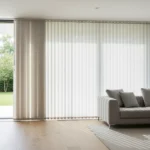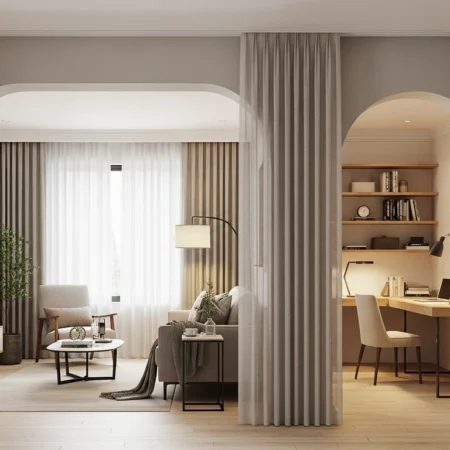Living in a studio apartment feels charming and freeing, until your bed stares at you while you eat dinner. The good news? You can divide your space without losing light, warmth, or personality. Thoughtful room dividers create gentle boundaries, add storage, and make your home feel intentionally designed rather than “one big room with furniture.”
Below, you will find twelve cozy room divider ideas that work beautifully in studio apartments. Each idea helps you carve out zones, boost comfort, and express your style, without turning your home into a maze of heavy walls.
1. Open Shelving That Doubles as a See-Through Wall

Open shelving offers one of the easiest and coziest room divider ideas for a studio apartment. Position a tall, backless shelf between your “living room” and “bedroom.” You instantly create two zones, yet daylight still flows through.
Style both sides with intention. Stack favorite books, woven baskets, framed photos, and a few trailing plants. Mix open space with clustered decor so the shelf feels light, not cluttered.
This divider works especially well when you align the bottom shelves with the back of your sofa. Suddenly, the sofa anchors a living area, while the upper shelves frame a more private sleeping nook. You gain storage, visual interest, and just enough separation to make each side feel like its own little world.
2. Floor-to-Ceiling Curtains for a Soft, Dreamy Partition

Curtains create a soft boundary that feels romantic rather than rigid. Install a ceiling track or tension rod across the area you want to divide, then hang floor-to-ceiling curtains in a cozy fabric. Think linen, cotton, or even velvet if you want extra drama and warmth.
You can pull the curtains back during the day so the studio feels open and spacious, then close them at night to cocoon your bed or workspace. The fabric absorbs sound, softens light, and adds a sense of privacy that a small space rarely offers.
Choose a color that whispers calm. Warm white, champagne, or a muted earthy tone works beautifully. When you draw those curtains in the evening, you create a quiet ritual that tells your brain, “Now we rest.”
3. A Slatted Wood Screen That Filters Light

A slatted wood screen divides space while it filters light like a modern forest. Slim vertical or horizontal slats create a semi-transparent wall that feels architectural but not heavy.
Place the screen near the foot of the bed or beside a small dining table to define a zone. The lines of the slats create rhythm and texture, which makes the studio feel designed rather than improvised. You can choose honey-toned wood for warmth, or a deeper walnut stain for a moody, cocooned vibe.
For extra function, attach small hooks on the screen’s side facing the entry for bags or scarves. The screen then guides your eye, organizes your stuff, and adds natural warmth, all in one elegant gesture.
4. A Double-Sided Bookcase Headboard Around the Bed

If you love the idea of a separate bedroom but live in 400 square feet, try a double-sided bookcase behind your bed. Position a low or mid-height bookcase where a headboard would usually sit, but face one side toward the bed and the other toward your living area.
On the “bedroom” side, store nighttime essentials: books, a small lamp, a candle, perhaps a tray for jewelry. On the “living room” side, treat the shelves like a console: display art, baskets with remote controls, and decorative objects.
This setup gives your bed a strong sense of place without a solid wall. You still see across the apartment, yet the bookcase creates just enough separation to make mornings feel less like you just rolled out of bed into your living room.
5. A Lush Plant Forest as a Living Divider

Plants create a divider that literally breathes. Group tall, leafy plants on a bench, low shelf, or row of stands between zones. Mix heights: a fiddle leaf fig or rubber plant in the back, medium plants in the middle, trailing varieties at the front.
The leafy silhouettes break up sightlines in a gentle way. You still catch glimpses of the area beyond, but greenery filters the view like a soft-focus lens. This living wall also purifies the air and introduces biophilic comfort, which matters in a compact space.
Choose planters that share a common thread, such as similar shapes or colors, so the ensemble feels cohesive. When you water and tend your plant divider, you do not just maintain decor; you care for a small indoor garden that makes your studio feel alive.
6. A Folding Screen With Personality

A folding screen solves several small-space challenges at once. It divides space, adds art, and folds away when you want an open layout.
Select a screen with a design that reflects your style: woven rattan for a beachy mood, fabric panels with subtle pattern for a soft, cozy look, or paneled wood with carved details for a vintage touch. Position it beside the bed or around a desk to create a sense of privacy during work calls or rest.
When guests visit, you can quickly unfold the screen to hide the bed or cluttered corner. When you want maximum floor space, you fold it flat and tuck it behind a sofa or along a wall. The flexibility feels luxurious in a small home.
7. sliding Panels on a Ceiling Track

Sliding panels turn one flexible gesture into multiple layouts. Mount a ceiling track and hang panels that glide smoothly to divide or open up the space. You can use fabric, woven shades, or light wood panels, depending on your style.
During the day, slide the panels aside to unite the apartment. In the evening, move them into place to carve out a snug bedroom or reading corner. You control how enclosed or open each zone feels, which helps the studio adapt to your mood.
Consider panels in a warm, textured fabric that echoes your sofa or bedding. That repetition makes the apartment feel cohesive, even when you rearrange the panels. You essentially script how your home behaves across the day, just by sliding a hand along that track.
8. A Glass or Acrylic Partition That Keeps the Light Flowing

When you want a clear boundary but refuse to sacrifice sunlight, a glass or acrylic partition offers a beautiful solution. Think of a slim-framed grid of glass panels or a single clear acrylic sheet that reaches partway or all the way to the ceiling.
This divider keeps the studio bright while it visually separates zones. You can place it near the entry to create a small “hallway,” or between the bed and living area to define a sleep sanctuary. Frosted or ribbed glass adds privacy and a soft glow, while clear glass maintains a fully open visual connection.
Add a narrow ledge or small shelf along the base for plants or candles. The light passes through, glints off glass, and turns your tiny apartment into a calm, luminous retreat.
9. A Raised Platform for the Bed With Storage Steps

A raised platform does not just divide space; it declares, “This is the bedroom.” Build or buy a low platform that lifts the bed a step or two above the rest of the apartment. Incorporate drawers or cubbies into the base, and use the side facing the living area as an informal divider.
That small change in height subtly signals a different zone, the way you move from one room to another in a larger home. The platform edge doubles as extra seating for friends, while the storage inside keeps clothes, linens, or seasonal items out of sight.
Layer a soft rug at the foot of the platform and add warm bedside lighting. When you climb those few steps at night, you leave the busy part of the studio and enter a cozy, elevated nest.
10. Color-Blocked Zones With Paint and Rugs

Sometimes you do not need a physical divider at all. You can use color to create invisible walls. Paint one section of the room in a warm accent color—perhaps the wall behind the bed or the wall that frames your sofa. Anchor that zone with a rug that echoes the wall color.
In another area, choose a different but complementary palette. Suddenly, you see distinct “rooms,” even though no structure stands between them. Color directs the eye and organizes the space.
To keep the studio cozy, choose soft, muted tones: clay, sage, oat, or dusty blue. Layer textures—chunky knit throws, woven cushions, and curtains that echo your color choices. Your apartment becomes a color story instead of a single white box.
11. Ceiling-Hung Rods and Hooks as a Light Grid

For a more minimal and creative divider, use the ceiling itself. Install a slim rod or track and hang a series of lightweight elements: fabric panels, hanging plants, lanterns, or decorative screens. The items create a vertical grid that loosely separates zones without blocking airflow or conversation.
You can change the hanging pieces with the seasons. Sheer linen panels in summer, warm-toned fabric and dried foliage in autumn, perhaps fairy lights woven through in winter. This approach turns the divider into a dynamic art installation rather than a fixed object.
Because everything hangs from above, the floor stays open and easy to clean. The divider feels light, playful, and surprisingly sculptural, especially when the elements sway slightly as you move around the room.
12. Mobile Storage Cubes as a Flexible Wall

When you crave constant flexibility, mobile storage cubes step in as a clever solution. Arrange a row of cube units on low-profile casters between zones. Some cubes stay open for display, while others hold baskets or doors for hidden storage.
You can roll the cubes closer together for a more solid divider, or spread them out to open the space. Turn a few at right angles to create a corner reading nook or a micro-entry with hooks and a small tray.
Because the cubes provide both storage and structure, they help a studio feel organized rather than cramped. When life changes—new job, new hobbies, new layout—you simply roll your “wall” to a fresh position and let the apartment evolve with you.
Bringing It All Together
A studio apartment offers more than a single multipurpose room. With the right room divider ideas, you can create zones that match your rhythms: a sunlight-filled morning corner, a focused workspace, a soft, protected place to sleep.
You do not need heavy walls to feel grounded at home. You need boundaries that support how you live, rest, and dream. Open shelving, curtains, plants, color, and clever storage all help you draw those lines gently.
Start with one divider that excites you. Let it carve out a nook you genuinely love spending time in. Then, build around that feeling. When every corner of your studio reflects intention and warmth, the whole place starts to feel less like “small space living” and more like a beautifully edited life.










